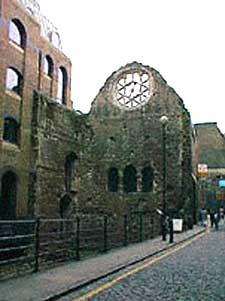|
|
 Wandering Wheels
Winchester House
Clink Street, Southwark, SE1
 The last remaining wall of this once fabulous palace with its magnificent rose window measuring thirteen feet across is enough to give a taste of the wealth and power that was enjoyed by the Bishops of Winchester. The last remaining wall of this once fabulous palace with its magnificent rose window measuring thirteen feet across is enough to give a taste of the wealth and power that was enjoyed by the Bishops of Winchester.
First constructed in 1109, Winchester House grew in size and status as the Bishops rose in rank within the state. For more than five centuries, the house and its 70 acres of parkland dominated London's South bank. The estate, known as the Liberty of the Clink, is now commemorated in the name of Clink Street and in the abiding memory of the infamous Clink prison which stood in the shadow of the palace.
From the 14th century, the period when the rose window was built, the Bishops of Winchester had close links with the monarchy and many noble visitors came to the palace to be entertained. In 1424, Cardinal Beaufort, the half-brother of Henry IV, organised a lavish wedding reception here for his niece, Jane. She had just married James I of Scotland at Southwark Cathedral. It was a love story with a happy ending, for the King had first seen Jane whilst being held captive by the English at Windsor. He described the moment, when he doubted whether she was ' ..a worldly creature/Or heavenly thing in likeness of Nature.' in a poem.
Another love story which is said to have begun at Winchester House was that between Henry VIII and Katherine Howard. Katherine's uncle, the Duke of Norfolk, used to arrange banquets at the palace and it was easy for him to contrive a meeting. Henry, who had married and just as quickly divorced Anne of Cleves in 1540 married Katherine the same year. The marriage - the King's fifth - soon soured and Katherine went to the block in 1542.
Winchester House was taken from the Bishops when Civil War broke out in 1642. The house was used as a prison for Royalists until after the war, when it was sold off. Although the house was returned to the church after the Restoration, it was allowed to deteriorate. All trace of the palace was lost after the site and the grounds of the old estate were built on in the 17th century.
Despite all this, the West wall of the original Great Hall survived. It was finally rediscovered when workmen started to demolish a derelict warehouse. The foundations of Winchester House were also revealed when the site was excavated.

Winchester House can be seen from street level
 London Bridge. London Bridge.
Copyright © Jan Collie 2002
Published by permission of the author.
All rights reserved. No reproduction, copy or transmission of this publication may be made without written permission.
| |
|